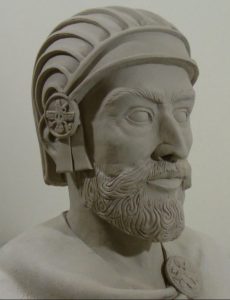By Cam Rea
Cyrus the Great or “Cyrus II” was King of Anshan from 559-530 BCE. He was the son of King Cambyses I of Anshan (580-559 BCE) and his mother, Mandane, was the daughter of King Astyages of Media. The names Cyrus and Cambyses are interesting, as both appear to be connected to the Indo-Iranian tribes of the Kuru and Kambysene. Moreover, they may have been Scythian.
As mentioned, Cyrus came to throne around 559 BCE, after most likely being a vassal to his overlord and grandfather, King Astyages of the Umman-manda. Around 553 BCE, he rebelled against King Astyages when he marched on the capital Ecbatana of his own accord to claim the throne. When Cyrus and Astyages’ forces clashed, many of the Umman-manda forces switched sides and joined Cyrus. It should be no surprise then that he defeated the Umman-manda and took his grandfather Astyages prisoner.
However, this is Herodotus’ view, as there are a few other sources one must consider.
Take, for instance, the Neo-Babylonian King Nabonidus. In Nabonidus’ first year as king, (556 or 555 BCE), he states in his chronicle that he had a dream given to him by the god Marduk:
“At the beginning of my lasting kingship they (the great gods) showed me a vision in a dream…. Marduk said to me, ‘The Umman-manda of whom thou speakest, he, his land, and the kings who go at his side, will not exist for much longer. At the beginning of the third year, Cyrus, king of Anshan, his youthful servant, will come forth. With his few forces he will rout the numerous forces of the Umman-manda. He will capture Astyages, the king of the Umman-manda, and will take him prisoner to his country.” (Yamauchi, Persia and the Bible, p. 80-81)
Putting mysticism aside, Nabonidus obviously received intelligence reports that Cyrus was going to rebel and declare independence from Astyages.
It seems that the Kingdom of Babylonia had had many problems with the Umman-manda, so perhaps Nabonidus’ dream was mere hope.
In Nabonidus’ seventh year, he had this to say about the conflict between Cyrus and Astyages:
“[Astyages] mobilized [his army] and he marched against Cyrus, king of Anshan, to conquer…. the army rebelled against Astyages and he was taken prisoner. They handed him over to Cyrus […]. Cyrus marched toward Ecbatana, the royal city. Silver, gold, goods, property, […] which he seized as booty [from] Ecbatana, he conveyed to Ansan. The goods [and] property of the army of […].” (Briant, From Cyrus to Alexander, p. 31)
King AstyagesFrom this inscription, we get a variation on the story described by Herodotus. The main difference is that it was Astyages who invaded Anshan to put down the rebellion. Then, in turn, his army rebelled and handed him over to Cyrus. However, this is not to say Herodotus was wrong. Herodotus says Cyrus invaded Media, which is partially right, but it was only after the battle and imprisonment of Astyages did Cyrus march on Media to take the Umman-manda capital, Ecbatana.
In addition, we must forget that this was not the end of the war between the two.
Even though Astyages was now a prisoner, the fight went on for three more years, not coming to a close until around 550 BCE.
But before that moment, Cyrus would lose three battles, and out of the many defeats, many would defect over to the Umman-manda side and vice versa.
It was only once the Umman-manda was finally defeated and vanquished that Cyrus entered the capital Ecbatana and sat on Astyages’ throne. Now the Persians were the new “masters of Asia.”
Tune in Next week to hear about his Armies and the destruction Cyrus will wreak…
Read Part Two here: Cyrus the Great – Armies










One comment
Hmm. Cam – short for Cambyses?
Trackbacks
Our apologies, you must be logged in to post a comment.